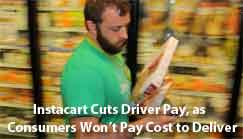Delivery Wars Push Comes to Shove at Instacart
We've reported many times on the on-going disconnect between what it costs "etailers" to ship and deliver products versus what if anything they receive as payments from customers.
This is highlighted by Amazon.com's policies for its Prime members, who for an annual fee of now $99 receive unlimited two-day shipping on almost all orders, and free same day delivery for orders over $35.00 in 16 US metro markets, and completely free two-hour delivery for many items.
|
With this shipping policy pressure from Amazon, other etailers have been forced to follow suit, making it tough for them and Amazon itself to turn a profit on ecommerce channels. (SeeAmazon's Stock Price and the Fate of Omnichannel Commerce.)
But maybe things are coming to a bit of a head. Relative newcomer Instacart, a much ballyhooed provider of fast grocery delivery services, announced it was cutting back on what it pays drivers to reduce its losses.
As first reported in the Wall Street Journal last week, contract drivers in the company's hometown of San Francisco will earn $1.50 a drop-off, a cut of 63% from the previous guarantee of $4. Instacart is also slashing by 50% to 25 cents the commission it pays for each item in an order when drivers actually select individual items for an on-line or mobile order.
After the news, Instacart said that ""We have made some recent rate changes to reduce variability in how much shoppers [meaning drivers] earn, and we are constantly innovating to help shoppers get more orders."
It added that "After these changes our shoppers will earn, on average, an effective rate of $15 to $20 per hour" - but those figures include tips, meaning pay from Instacart is even less.
The company used a somewhat higher range of likely wages, again including tips, in an email to drivers relative to the change, saying they would still likely to make $18-20 per hour.
That relatively modest rate per hour comes before the drivers have to pay for their own gas, insurance and in some cases other fees. At least for the time being they are benefitting from relatively low gas prices.
The bottom line, Bloomberg reports, is that Instacart knows that "it costs much more to deliver an order than the $5.99 it charges shoppers, but customers are unwilling to pay more."
That's a real problem when initially Instacart's business model was to make money primarily just from delivery fees - a UPS for the grocery industry.
So push is now finally comes to shove in on-line delivery.
Thus step one for Instacart is to reduce what it pays its driver/shopper pool. Will that pay cut reduce the number of people willing to foot their own expenses to make maybe $15-20 per hour? That obviously remains to be seen.
Drivers will clearly make less for now. The Wall Street Journal reported that a shopping and delivery trip for 20 unique items to one customer would net a driver $15 under the existing rate structure, but only $12.50 when the new rates take effect next week, not including tips. It said the new rules will make getting paid even $10.00 for many deliveries will be difficult.
 With larger orders, the loss in pay for drivers is worse. A 40-item delivery today pays $25.00, excluding tips, but would drop to $17.50 in the new structure - a substantial decrease. We're not sure how many customers are order 40 items on line, but still…
With larger orders, the loss in pay for drivers is worse. A 40-item delivery today pays $25.00, excluding tips, but would drop to $17.50 in the new structure - a substantial decrease. We're not sure how many customers are order 40 items on line, but still…
Step two is to find other sources of revenue. Instacart, for example, is looking to brand companies to offset some of the delivery cost when consumers order products through the company. Recently, for instance, delivery was free for customers ordering at least $10 worth of products from energy drink maker Red Bull. That seems like a tough economic proposition for a $5.99 delivery fee, but again we will see.
On the bullish side, food giant Nestlé ran two campaigns last year offering free delivery to Instacart customers who ordered $15 of DiGiorno frozen pizzas or Häagen-Dazs super-premium ice cream. A company executive at Nestlé said he was "happy with the results" of the test, though the financial math looks suspect to SCDigest.
For awhile, Instacart tried to make money by charging more for items ordered through its site than the price available in-store. That led to customer complaints, and now most (but not all) products do have the same prices as in-store. Instacart makes money through a commission paid by retailers such as Whole Foods and Target stores.
With these and other moves, such as advertising by retailers and brand companies on its web site, delivery fees paid by customers now make up less than half of the company's total revenue - though it continues to lose money. It also has a program that offers unlimited free delivery for an annual fee of $149, up from an Amazon matching $99 in 2015.
What's more, Instagram has started the process of moving some its current freelance drivers to part-time employee status, as many states are pushing for changes in how such employees are categorized. That would require Instacart to pay a driver's expenses and unemployment insurance and other benefits, and potentially face the prospect of unionization.
Still, recent invesments valued Instacart at some $2 billion. Whole Foods plans to invest in the delivery startup and sign a five-year agreement, recent reports have said.

No comments:
Post a Comment